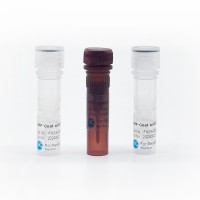Compared to most common posttranslational modifications of proteins, a peculiarity of poly(ADP-ribosyl)ation is the molecular heterogeneity and complexity of the reaction product, poly(ADP-ribose) (PAR). In fact, protein-bound PAR consists of variously sized (2–200 ADP-ribose residues) linear or branched molecules, negatively charged at physiological pH. It is now clear that PAR not only affects the function of the polypeptide to which it is covalently bound, but it can also influence the activity of other proteins by engaging specific noncovalent interactions. In the last 10 years, the family of PAR-binding proteins has been rapidly growing and functional studies have expanded the regulatory potential of noncovalent �protein targeting by PAR far beyond initial assumptions.
In this chapter, methods are described for: (1) PAR synthesis and analysis; (2) detecting PAR-binding proteins in protein mixtures; (3) defining affinity and specificity of PAR binding to individual proteins or protein fragments; and (4) identifying PAR molecules selectively involved in the interaction.
![Recombinant-Rat-Poly-ADP-ribose-polymerase-16Parp16Poly [ADP-ribose] polymerase 16; PARP-16
EC= 2.4.2.30](https://img1.dxycdn.com/p/s14/2024/1230/771/6125898111540663781.jpg!wh200)



![PARP14/PARP14蛋白Recombinant Human Poly [ADP-ribose] polymerase 14 (PARP14)重组蛋白Protein mono-ADP-ribosyltransferase PARP14蛋白](https://img1.dxycdn.com/p/s14/2024/0914/795/0844698182989384381.jpg!wh200)

